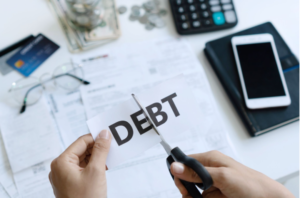
How to Quickly Get Rid of Debt in Canada
Debt can be a major source of stress and anxiety for many Canadians. Whether it’s credit card debt, student loans, or other forms of debt, it can be challenging to manage and it can get out of control if left unchecked. However, there are steps you can take to quickly get rid of debt in Canada, let’s find out in this article.
Factors that Can Make Getting Rid of Debt Difficult
- Lack of Income: If a person doesn’t have enough income to cover their debt payments, it will be difficult to get rid of their debt. This is especially true if they have high-interest debt, such as credit card debt, which can quickly accumulate if payments are missed.
- High Debt-to-Income Ratio: Even if a person has a good income, they may still struggle to get rid of their debt if their debt-to-income ratio is too high. This ratio is calculated by dividing a person’s monthly debt payments by their monthly income, and if it is too high, lenders may be hesitant to lend them more money.
- Unforeseen Expenses: Unexpected expenses, such as medical bills, and home or car repairs, can eat away at a person’s ability to pay off their debt. This is why it’s important to have an emergency fund in place to cover unexpected expenses.
- No Budget: If a person doesn’t have a budget in place, they may not be aware of where their money is going, and they may be overspending in certain areas. By creating a budget and sticking to it, they can prioritize debt repayment and ensure they have enough money to cover their expenses.
- Inflation: When the value of the dollar depreciates, and you have to pay more to get the same quantity of product and services, this would affect your budget and also cause an increase in interest rates, thereby making debt more expensive and difficult to deal with.
How to Quickly Get Rid of Debt in Canada
Create a Budget and Stick to It
One of the most important steps to getting rid of debt is creating a budget. A budget will help you understand exactly how much money you have coming in and going out each month, and it will help you identify areas where you can cut back on expenses.
To create a budget, start by listing all your sources of income, including your salary, any side hustles, and any government benefits you receive. Then, list all your expenses, including rent/mortgage, utilities, groceries, transportation costs, and any other bills you have. Subtract your expenses from your income, then you will know how much you have left.
If you find that you don’t have any money left over, or if you’re spending more than you’re making, you’ll need to make some tough decisions. Look for areas where you can cut back on expenses, such as eating out less, canceling subscriptions you don’t use, etc.
Prioritize Your Debts

Once you have a budget in place, you’ll need to prioritize your debts. Make a list of all your debts on a piece of paper, including the principal amount, and the interest you will be paying. Then, you can prioritize these debts based on the size of the interest. Debts with the highest interest rates usually cost you the most money. By focusing on these debts first, you’ll be able to save money in the long run.
Consolidate Your Debts
Consolidating your debts can be an effective way to get rid of debt quickly. There are several ways to consolidate debt, including taking out a personal loan, using a balance transfer credit card, or using a home equity loan.
Consolidating your debt means you’re taking out a new loan to pay off multiple debts. This can help simplify your finances by reducing the number of payments you have to make each month, and it can also help you save money by lowering your interest rates.
Make Extra Payments
Making extra payments on your debts can also help you get rid of debt quickly. Even if you can only afford to make small extra payments, it can add up over time and help you pay off your debts faster.
To make extra payments, start by identifying areas in your budget where you can cut back on expenses. Then, use the money you save to make extra payments on your debts.
Use the Snowball Method
The snowball method is a debt repayment strategy where you focus on paying off your smallest debts first, then use the money you save to pay off your larger debts. The idea is that by focusing on your smaller debts first, you’ll be able to build momentum and stay motivated as you work towards paying off your larger debts.
To use the snowball method, start by listing all of your debts from smallest to largest. Then, focus on paying off your smallest debt first, while making minimum payments on your other debts. Once you’ve paid off your smallest debt, take the money you were using to pay that debt and put it towards your next smallest debt.
Get Help From Debt Experts

If you’re struggling with debt and don’t know where to turn, seeking professional help can be a good option. Dealing with debt can be stressful and overwhelming. Our debt experts at EmpireOne Credit can offer support and guidance on your way to debt-freedom. We offer a free and confidential consultation, and your debt can be reduced by up to 80%, and interest will stop right away. Call us at (416) 900-2324 to schedule a free consultation with us. Being debt-free feels good!





